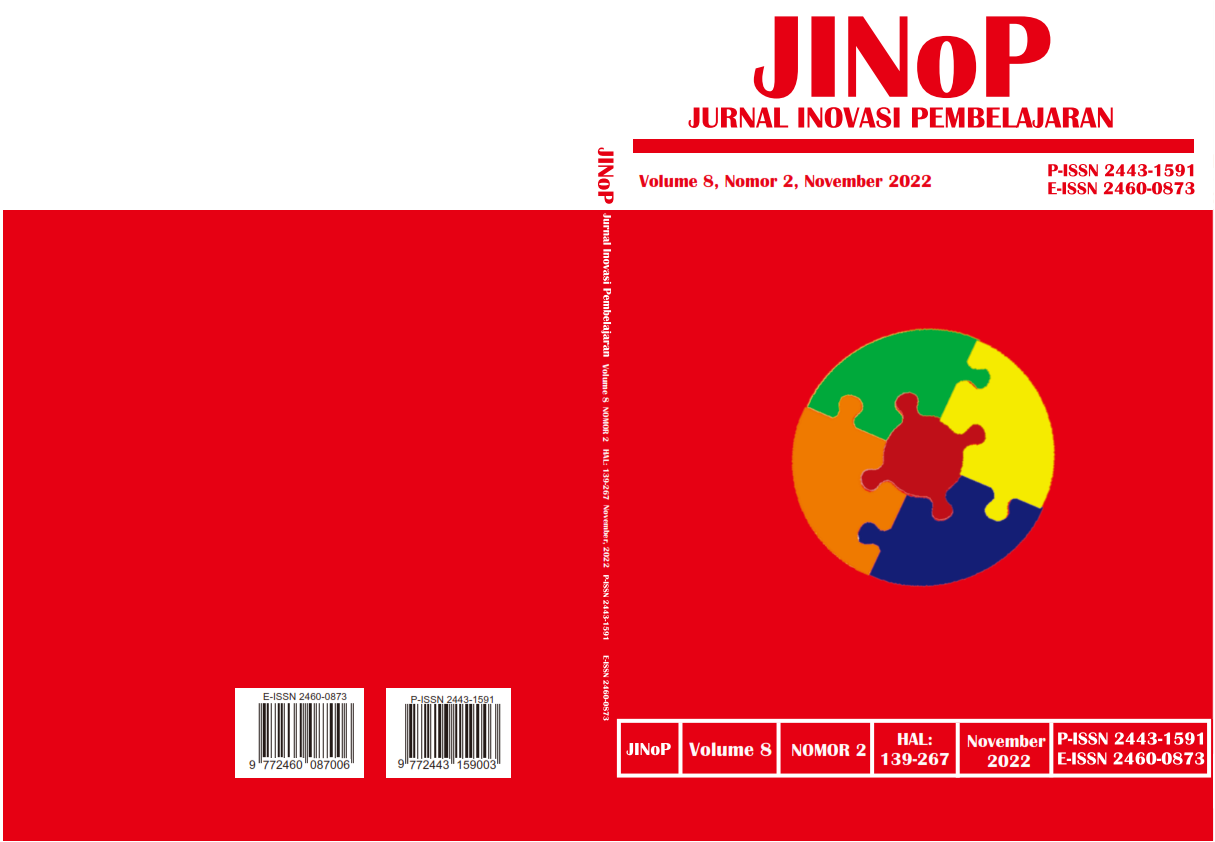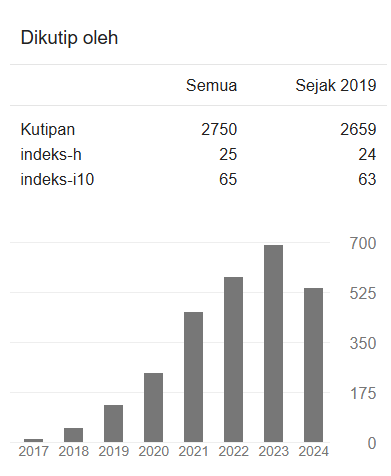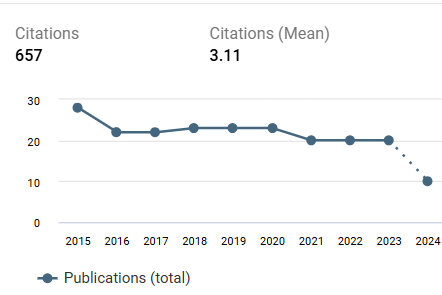Konstruksi Model Pembelajaran STEAM (Science, Technology, Engineering, Arts, and Mathematics) dengan Pendekatan Design Thinking pada Materi Energi Terbarukan
DOI:
https://doi.org/10.22219/jinop.v8i2.22456Keywords:
Design Thinking, Renewable Energy, STEAM, Project Based Learning, Science LiteracyAbstract
Industrial revolution 4.0 accelerates the need for resources with contextual skills relevant to technological advances. Renewable energy is one of the global issues that need to be followed up into one of the concerns in education. The STEAM (Science, Technology, Engineering, Arts, and Mathematics) learning concept is seen as a learning innovation that accommodates the skills needed in the era of the industrial revolution 4.0. In addition, through the design thinking approach, students are facilitated to realize creativity or ideas in solving surrounding problems. This study aims to reconstruct the STEAM learning model with a combination of design thinking approaches to renewable energy learning materials. This research uses a descriptive qualitative approach to data sources from the literature. The analysis tool used is Miles and Huberman interactive model data analysis. The purpose of this research is to formulate a combined framework of the STEAM learning model and design thinking that can be applied to renewable energy learning materials.
Downloads
References
Ahmad, D. N., Astriani, M. M., Alfahnum, M., & Setyowati, L. (2021). Increasing creative thinking of students by learning organization with steam education. Jurnal Pendidikan IPA Indonesia, 10(1), 103–110. https://doi.org /10.15294/jpii.v10i1.27146
Bruri, M. T. (2017). Pendidikan vokasi yang berada di jalur berbeda dengan pendidikan jalur akademi . pada abad 18-19 melalui industri empat seperti yang tersebutkan di. Tantangan Revolusi Industri Ke 4 (I4.0) Bagi Pendidikan Vokasi, 4, 1–5.
Bybee, R. W. (2010). Advancing STEM Education: A 2020 Vision. Technology and Engineering Teacher, 70(1), 30–35.
Chung, C. C., Huang, S. L., Cheng, Y. M., & Lou, S. J. (2020). Using an iSTEAM project-based learning model for technology senior high school students: Design, development, and evaluation. Int J Technol Des Educ. https://doi.org/10.1007/s10798-020-09643-5
Colucci-Gray, L., Trowsdale, J., Cooke, C. F., Davies, R., Burnard, P., & Gray, D. S. (2017). Reviewing the potential and challenges of developing STEAM education through creative pedagogies for 21st learning: How can school curricula be broadened towards a more responsive, dynamic, and inclusive form of education? British Educational Research Association.
Daugherty, M. K. (2013). The prospect of an "A" in STEM education. Journal of STEM Education: Innovations and Research, 14(2), 10–15.
Febriansari, D., Atmojo, I. R. W., Ardiansyah, R., & Januardy, S. (2021). NgaBatik: Application Interactive Games to Learn about Design Batik Ngawi Based Android through the Application of STEAM Learning Model. Journal of Physics: Conference Series, 1842(1). https://doi.org/10.1088/17 42-6596 /1842/1/012009
Gates, A. E. (2017). Benefits of a STEAM collaboration in Newark, New Jersey: Volcano simulation through a glass-making experience. Journal of Geoscience Education, 65(1), 4–11.
Hawari, A. D. M., & Noor, A. I. M. (2020). Project-Based Learning Pedagogical Design in STEAM Art Education. Asian Journal of University Education, 16(3), 102–111. https://doi.org/10.24191/ajue.v16i3.11072
Henriksen, D. (2017). Creating STEAM with Design Thinking: Beyond STEM and Arts Integration. Steam, 3(1), 1–11. https://doi.org/10.5642/steam.20170 301.11
Hlukhaniuk, V., Solovei, V., Tsvilyk, S., & Shymkova, I. (2020). Steam Education As a Benchmark for Innovative Training of Future Teachers of Labour Training and Technology. Proceedings of the International Scientific Conference, 1(1), 211–221. https://doi.org/10.17770/sie2020vol1.5000
Ishartono, N., Sutama, Prayitno, H. J., Irfan, M., Waluyo, M., & Sufahani, S. F. Bin. (2021). An Investigation of Indonesian In-Service Mathematics Teachers’ Perception and Attitude Toward STEAM Education. Journal of Physics: Conference Series, 1776(1). https://doi.org/10.1088/1742-6596/1776 /1/012021
Kamienski, N., & Radziwill, N. (2018). Design for STEAM: Creating Participatory Art with Purpose. Steam, 3(2), 1–17. https://doi.org/10.5642/steam.20180 302.08
Kangas, K , Seitamaa-Hakkarainen, P & Hakkarainen, K. (2013). Design Thinking in Elementary Students’ Collaborative Lamp Designing Process. Design and Technology …, 18(1), 30–43.
Long, R., & Davis, S. (2017). Using STEAM to Increase Engagement and Literacy y Across Disciplines. Steam, 3(1), 1–11. https://doi.org/10.5642/steam.2017 0301.07
Marshall, J. (2014). Transdisciplinarity and art integration: Toward a new understanding of art-based learning across the curriculum. Studies in Art Education, 55(2), 104–127.
Martin, A. J., Mansour, M., Anderson, M., Gibson, R., Liem, G. A., & Sudmalis, D. (2013). The role of arts participation in students’ academic and nonacademic outcomes: A longitudinal study of school, home, and community factors. Journal of Educational Psychology, 105(3), 709–727.
Melles, G., Anderson, N., Barrett, T., & Thompson-Whiteside, S. (2015). Problem Finding through Design Thinking in Education. In Inquiry-Based Learning for Multidisciplinary Programs: A Conceptual and Practical Resource for Educators (Vol. 3, pp. 191–209). Emerald Group Publishing Limited. https://doi.org/10.1108/S2055-364120150000003027
Menteri Pendidikan dan Kebudayaan. (2013). Peraturan Menteri Pendidikan dan Kebudayaan RI No 67 Tahun 2013 tentang Kerangka Dasar dan Struktur Kurikulum SD/MI. In Kementerian Pendidikan dan Kebudayaan RI. (pp. 1–135).
Moleong, L. J. (2018). Metodologi Penelitian Kualitatif (Edisi revi). Bandung : PT Remaja Rosdakarya.
Payton, F. C., White, A., & Mullins, T. (2017). STEM majors, art thinkers–issues of duality, rigor and inclusion. Journal of STEM Education: Innovations and Research, 18(3), 39–47.
Perignat, E. and Katz-Buonincontro, J. 2018. STEAM in Practice and Research: An Integrative Literature Review. Thinking Skills and Creativity 31: 31-43.
Plattner, H. (2018). An introduction to Design Thinking. In the Institute of Design at Stanford.
Quigley, C. F., Herro, D., & Jamil, F. M. (2017). Developing a conceptual model of STEAM teaching practices. School Science and Mathematics, 117(1-2), 1–12.
Rabkin, N., & Hedberg, E. C. (2011). Arts education in America: What the declines mean for arts participation. Based on the 2008 survey of public participation in the arts. Research report# 52. National Endowment for the Arts.
Radziwill, N., Benton, M., & Moellers, C. (2015). From STEM to STEAM: Refra ming What it Means to Learn. Steam, 2(1), 1–7. https://doi.org/10.5642/stea m.20150201.3
Razzouk, R., & Shute, V. (2012). What Is Design Thinking and Why Is It Important? Review of Educational Research, 82(3), 330–348. https://doi.org/10.31 02/0034654312457429
Root-Bernstein, R. (2015). Arts and crafts as adjuncts to STEM education to foster creativity in gifted and talented students. Asia Pacific Education Review, 16(2), 203–212.
Sajidan, S., Saputro, S., Perdana, R., Atmojo, I. R. W., & Nugraha, D. A. (2020). Development of Science Learning Model towards Society 5.0: A Conceptual Model. Journal of Physics: Conference Series, 1511(1), 0–9. https://doi.org /10.1088/1742-6596/1511/1/012124
Shatunova, O., Anisimova, T., Sabirova, F., & Kalimullina, O. (2019). Journal of Social Studies Education Research STEAM as an Innovative Educational Technology. Journal of Social Studies Education Research, 10(2), 131–144.
Sungkono, S. (2006). Pembelajaran Tematik Dan Implementasinya Di Sekolah Dasar. Majalah Ilmiah Pembelajaran, 2(1), 51–58.
Supriyadi, S. (2020). Mengantar Siswa Menjadi Insinyur Kecil Yang Berkarakter Sebuah Penerapan Inovasi Pembelajaran abad 21 di Era Industri 4.0. Repo sitori Kemdikbudristek. http://repositori. kemdikbud.go.id/id/eprint/19224
Swaminathan, S., & Schellenberg, E. G. (2015). Arts education, academic achievement and cognitive ability. In P. P. Tinio, & J. K. Smith (Eds.). The Cambridge handbook of the psychology of aesthetics and the arts (pp. 364–384). New York: Cambridge University Press
Syarif, M. I. (2020). Disrupsi Pendidikan IPA Sekolah Dasar dalam Menyikapi Merdeka Belajar dan Kampus Merdeka Menuju New Normal Pasca COVID-19. Jurnal Basicedu, 4(4), 927–937. https://doi.org/10.31004/basicedu.v4i4. 487
Thibaut, L., Ceuppens, S., De Loof, H., De Meester, J., Goovaerts, L., Struyf, A., Boeve-de Pau, J., Dehaene, W., Deprez, J., De Cock, M., Hellinckx, L., Knipprath, H., Langie, G., Struyven, K., Van de Velde, D., Van Petegem, P., & Depaepe, F. (2018). Integrated STEM Education: A Systematic Review of Instructional Practices in Secondary Education. European Journal of STEM Education, 3(1), 1–12. https://doi.org/https://doi.org/10.20897/ejsteme/85525
Thuneberg, H., Salmi, H., & Fenyvesi, K. (2017). Hands-on math and art exhibition promoting science attitudes and educational plans. Education Research International, 1–13.
Wijayanti, A. I., Pudjawan, K., & Margunayasa, I. G. (2015). Analisis Kemampuan Berpikir Kritis Siswa Kelas V Dalam Pembelajaran Ipa Di 3 Sd Gugus X Universitas Pendidikan Ganesha. E-Journal PGSD Universitas Pendidikan Ganesha, 3(1), 1–12.
Downloads
Published
How to Cite
Issue
Section
License
Copyright (c) 2022 Febriansari et al

This work is licensed under a Creative Commons Attribution 4.0 International License.
Copyright Notice
Authors who publish with JINoP (Jurnal Inoasi Pembelajaran) agree to the following terms:
- For all articles published in the JINoP (Jurnal Inovasi Pembelajaran), copyright is retained by the authors. Authors give permission to the publisher to announce the work with conditions. When the manuscript is accepted for publication, the authors agree to the automatic transfer of the publishing right to the publisher.
- Authors retain copyright and grant the journal the right of first publication with the work simultaneously licensed under a Creative Commons Attribution 4.0 International License. that allows others to share the work with an acknowledgment of the work's authorship and initial publication in this journal.
- Authors are able to enter into separate, additional contractual arrangements for the non-exclusive distribution of the journal's published version of the work (e.g., post it to an institutional repository or publish it in a book), with an acknowledgment of its initial publication in this journal.
- Authors are permitted and encouraged to post their work online (e.g., in institutional repositories or on their website) prior to and during the submission process, as it can lead to productive exchanges, as well as earlier and greater citation of published work (See The Effect of Open Access).








